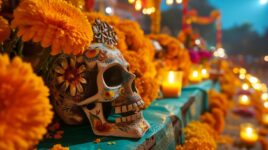
How Does Guatemala Celebrate Day of the Dead
How does Guatemala celebrate Day of the Dead? Day of the Dead, or Dia de los Muertos in Spanish, is a significant and vibrant tradition in Guatemala, where it is celebrated with deep reverence and colorful festivities.
This article will provide an in-depth look at the various aspects of how Guatemala celebrates this important holiday, including the significance of Day of the Dead in Guatemalan culture, traditional preparations, altars, foods and drinks, processions and parades, artwork and crafts, music and dance, Maya traditions, as well as modern celebrations.
Day of the Dead holds great importance in Guatemalan culture as it is a time to honor departed loved ones and to remember them with love and respect. The traditions and customs surrounding this holiday are rich with symbolism and history that reflect the blending of indigenous Maya beliefs with Catholic influences brought by Spanish colonization.
Guatemalan families engage in elaborate preparations for Day of the Dead, including cleaning and decorating gravesites with colorful flowers, candles, and offerings such as food and beverages. Altars are also set up in homes adorned with photographs of deceased family members along with their favorite foods, drinks, and other mementos.
One of the most visually striking elements of Day of the Dead in Guatemala is the intricate altars that are designed to welcome back the spirits of loved ones. These altars are adorned with marigolds, sugar skulls, incense, copal resin and often feature personal items that were cherished by those who have passed away.
The traditional foods associated with Day of the Dead in Guatemala include Fiambre – a unique salad prepared only during this time which combines a diverse range of flavors. Other favorites include tamales colorados (red tamales) or tamales negros (black tamales), which are made using corn dough filled with meat or beans then wrapped in banana leaves before being steamed. To accompany these dishes there is hot chocolate or atol (a thickened drink usually flavored with cinnamon).
In addition to these visual displays and culinary delights come vibrant processions through Guatemala’s streets featuring colorful costumes adorned with flowers. These captivating processions often include participants wearing skeleton masks while musicians play upbeat tunes on traditional instruments like marimbas.
The unique blend between customs inherited from Maya traditions alongside religious practices can be clearly seen throughout these celebrations. It truly is a fascinating spectacle showcasing both spiritual devotion as well as lighthearted celebration reminiscent from ancient times.
The Significance of Day of the Dead in Guatemalan Culture
The observance of Day of the Dead, or Día de los Muertos, is deeply rooted in Guatemalan culture and holds great significance for the people of Guatemala. This traditional holiday, which takes place on November 1st and 2nd, is a time for Guatemalans to honor their deceased loved ones and celebrate the continuity of life.
One of the most important aspects of Day of the Dead in Guatemala is the belief that during this time, the spirits of departed family members return to be with their living relatives. As a result, Guatemalans go to great lengths to create a welcoming environment for these spirits, including decorating altars with offerings such as flowers, candles, food, and other items that were meaningful to their departed loved ones.
This holiday also serves as a way for Guatemalans to connect with their cultural heritage and traditions. By participating in Day of the Dead celebrations, individuals are able to pay homage to their ancestors and keep their memories alive through rituals and customs that have been passed down through generations.
It’s important to note that while Day of the Dead may share some similarities with Halloween, it is a distinctly different holiday with its own set of customs and interpretations. In Guatemala, this holiday is not about fear or spooky decorations; rather, it’s a heartfelt and joyous occasion filled with love, respect, and reverence for those who have passed on.
Moreover, understanding the significance of Day of the Dead in Guatemalan culture provides insight into the values and belief systems that are foundational to this Central American country. The interweaving of indigenous Maya traditions with Catholic influences has resulted in a unique blend of spirituality and reverence for ancestral wisdom that is beautifully reflected in Guatemala’s observance of Day of the Dead.
Overall, Day of the Dead holds a special place in Guatemalan culture as a time-honored tradition that brings communities together in remembrance and celebration. From colorful altars to vibrant processions and parades, this holiday offers an immersive experience into the rich tapestry of cultural practices that define Guatemala’s identity.
| Day of the Dead Tradition | Significance |
|---|---|
| Creating altars with offerings | Honoring deceased loved ones |
| Rituals passed down through generations | Connecting with cultural heritage |
| Mixing indigenous Maya traditions with Catholic influences | Unique expression of spirituality |
| Vibrant processions and parades | Celebratory nature of holiday |
Traditional Guatemalan Day of the Dead Preparations
The preparations for the Day of the Dead in Guatemala are deeply rooted in tradition and hold a significant place in the hearts of the Guatemalan people. The days leading up to this important holiday are filled with meaningful rituals and customs that pay homage to departed loved ones.
Cleaning and Decorating Graves
One of the most important preparations for Day of the Dead in Guatemala is the cleaning and decorating of graves. Families visit cemeteries to tidy up the resting places of their ancestors, removing any debris or overgrown vegetation. Once the graves are cleaned, they are adorned with colorful flowers, candles, and handcrafted decorations. This act symbolizes the respect and love that Guatemalans have for their deceased family members.
Making Kites
In some regions of Guatemala, another traditional preparation for Day of the Dead involves making elaborate kites. These kites, known as “barriletes,” are handcrafted with intricate designs and vibrant colors. It is believed that flying these kites on November 1st helps guide the spirits of the departed back to earth to join in the Day of the Dead celebrations.
Cooking Traditional Foods
Another integral part of preparing for the Day of the Dead in Guatemala is cooking traditional foods that hold special significance. Families come together to prepare a variety of dishes such as “fiambre,” a cold salad made with an assortment of meats, cheeses, and vegetables. In addition, sweet breads known as “pan de muerto” are baked and enjoyed during this time.
Creating Altars at Home
Guatemalan families also engage in creating altars at home to honor their deceased relatives. These altars are adorned with photographs, candles, marigolds, personal belongings of the departed, and their favorite food and drinks. Each item placed on the altar holds symbolic meaning and serves as a way to remember and celebrate the lives of those who have passed away.
As we delve into understanding how does Guatemala celebrate Day of The Dead preparations show us just how deeply ingrained these traditions are in Guatemalan culture; each ritual serving as a beautiful way to honor and remember loved ones who have passed on.
An Inside Look at the Colorful Day of the Dead Altars in Guatemala
The Day of the Dead in Guatemala is a vibrant and colorful celebration that is filled with traditions and customs that have been passed down through generations. One of the most striking aspects of this celebration is the creation of intricate altars that are adorned with flowers, candles, and various offerings to honor deceased loved ones.
In Guatemalan culture, the Day of the Dead holds great significance as it is a time when families come together to remember and celebrate the lives of those who have passed away. The altars, known as “altares de muertos,” are central to these commemorations as they serve as a focal point for paying tribute to ancestors and departed souls.
These beautiful altars are meticulously arranged with marigolds, known as “Flor de Muerto” or flower of the dead, which are believed to help guide spirits back to the world of the living. Additionally, families decorate their altars with photographs of their loved ones, along with their favorite foods, drinks, and personal belongings as offerings.
A common element found on Guatemalan Day of the Dead altars is the use of colorful paper decorations such as tissue paper banners and papel picado. These vibrant embellishments add a lively and festive touch to the altars, creating a visually stunning display that captures the essence of this cultural celebration.
The act of creating these ornate altars in Guatemala exemplifies how deeply rooted tradition and spirituality are in this event. Families take great care in designing their altars, ensuring that every detail is thoughtfully considered to honor their departed relatives and friends in a meaningful way.
Overall, these colorful Day of the Dead altars in Guatemala serve not only as a visual spectacle but also as an expression of love, respect, and remembrance for those who have passed on. Through these beautifully crafted displays, Guatemalans embrace their heritage and continue to preserve the rich cultural traditions associated with this yearly commemoration.
| Day of the Dead Altar Elements | Description |
|---|---|
| Marigolds (Flor de Muerto) | Believed to guide spirits back to the world of living |
| Photographs & Personal Belongings | Displayed as offerings for departed loved ones |
| Vibrant Paper Decorations | Add a lively and festive touch to the altars |
The Unique Guatemalan Day of the Dead Foods and Drinks
The Day of the Dead in Guatemala is a time for families to come together to honor and remember their loved ones who have passed away. This beautiful tradition is deeply rooted in Guatemalan culture and is celebrated with various rituals, customs, and of course, delicious foods and drinks.
During the Day of the Dead festivities in Guatemala, traditional dishes and beverages play a significant role in the celebrations. Families prepare special meals that hold great significance and are believed to help the spirits feel welcome and content as they return to visit their loved ones.
Here are some of the unique Guatemalan Day of the Dead foods and drinks that are enjoyed during this important holiday:
- Fruit Punch (Ponche): A warm, sweet beverage made with fruits such as pineapple, apples, raisins, and sugarcane. It is often spiced with cinnamon and clove, creating a comforting drink that warms both body and soul.
- Fiambre: This is perhaps the most iconic dish of the Day of the Dead in Guatemala. Fiambre is a colorful salad made with a wide array of meats, cheeses, vegetables, pickles, and hard-boiled eggs. Each family has its own unique recipe for this dish.
- Tamales: Tamales are a staple food during Guatemalan celebrations, including Day of the Dead. These delicious parcels of corn dough filled with various meats or vegetables are wrapped in banana leaves or corn husks and steamed to perfection.
- Kak’ik: This spicy turkey soup is often served during Day of the Dead festivities. Made with roasted tomatoes, chilies, cilantro, and other aromatic spices, Kak’ik is a warming and flavorful dish that holds deep cultural significance.
In addition to these delectable dishes, it is common for families to prepare special breads and sweets such as molletes (sweet bread rolls), hojaldras (puff pastries), tamales colorados (red tamales), atoles (traditional hot drinks thickened with masa), and more.
During this time, it’s also customary for families to prepare an offering table or altar where they place these foods alongside items that were cherished by their departed loved ones. The belief is that by providing their favorite foods and drinks for them to enjoy once again while visiting from another realm ensures they receive comfort during their short stay on Earth.
The traditions surrounding food and drink during Day of the Dead highlight how important it is for Guatemalans to preserve their customs while honoring their ancestors. These culinary traditions create a strong bond between generations – past, present, and future – providing a tangible link between those who have passed on before us.
Understanding the Mesmerizing Guatemalan Day of the Dead Processions and Parades
Guatemala is renowned for its mesmerizing Day of the Dead processions and parades, which are deeply ingrained in the country’s rich cultural heritage. These vibrant and colorful events play a crucial role in honoring and celebrating the lives of departed loved ones. The elaborate processions and parades showcase the unique blend of indigenous Mayan traditions and Catholic influences, creating a truly captivating experience.
The Symbolism of Day of the Dead Processions
During the Day of the Dead processions, Guatemalans come together to create intricate floral carpets known as “alfombras” using colorful sawdust, flowers, fruits, and other natural materials. These alfombras serve as a symbol of the temporary nature of life and the beauty that can be created even in times of mourning. The processions also feature participants dressed in traditional clothing and adorned with elaborate masks, adding to the visual spectacle that is unique to Guatemalan culture.
The Role of Music and Dance
Music and dance are integral components of Guatemalan Day of the Dead processions. Traditional marimba music fills the air as people dance along the streets, creating a joyous atmosphere despite the solemn nature of the occasion. This lively celebration serves as a way for Guatemalans to express their love for their departed ancestors while also embracing life and all its wonders.
Communal Participation
One striking aspect of these processions is that they are not limited to specific towns or regions; rather, they are celebrated throughout Guatemala. Each community takes pride in organizing its own procession, with families working together to create stunning displays and altars dedicated to their departed loved ones. This communal participation fosters a sense of unity and collective remembrance as people come together to honor those who have passed on.
Maya Traditions in Day of the Dead Processions
The Day of the Dead processions in Guatemala also reflect deep-rooted Maya traditions. The use of vibrant colors, intricate designs, and symbols drawn from ancient Mayan beliefs adds an unmistakable indigenous flair to the celebrations. This integration highlights the enduring influence of Maya culture on contemporary Guatemalan customs, making these processions truly unique to the region.
From elaborate floral carpets to traditional music and dance, the Day of the Dead processions in Guatemala offer a captivating glimpse into the country’s diverse cultural tapestry while providing insight into how modern Guatemalans continue to honor this important tradition.
Exploring the Beautiful Day of the Dead Artwork and Crafts in Guatemala
Guatemala is known for its rich and vibrant traditions, and the celebration of Day of the Dead is no exception. One of the most visually stunning aspects of this holiday in Guatemala is the beautiful artwork and crafts that are created to honor the deceased. From intricate paper cutouts to colorful ceramic skulls, Guatemalan artisans pour their creativity and skill into crafting items that are both poignant and breathtaking.
Some of the most striking Day of the Dead artwork in Guatemala can be found in the form of traditional textiles. Indigenous communities throughout Guatemala create stunning embroidered pieces that depict scenes of daily life as well as representations of death and the afterlife. These textiles are often used to adorn altars dedicated to deceased loved ones, adding a personal touch to the commemoration.
In addition to textiles, Guatemalan artisans also create elaborate masks adorned with feathers and beads. These masks, known as “caretas,” are worn during parades and processions as a way to both honor and mock death. The intricate detailing on these masks reflects the deep spiritual significance of Day of the Dead in Guatemalan culture.
Another quintessential Day of the Dead craft in Guatemala is that of making small wooden sculptures known as “cucuruchos.” These sculptures often represent skeletons engaged in everyday activities or traditional Mayan customs. They serve as a reminder of the lightheartedness with which death is viewed during this holiday, emphasizing joy rather than sorrow.
To encapsulate all these beautiful creations, Guatemalan artisans also produce vibrant papel picado (perforated paper) banners. These delicate paper cutouts feature intricate designs and cheerful colors, adding a festive atmosphere to Day of the Dead celebrations.
As you can see, exploring Guatemalan Day of the Dead artwork and crafts provides a window into the heart and soul of this revered holiday. The meticulous attention to detail and vibrant colors demonstrate how deeply ingrained this tradition is in Guatemalan culture, making it a truly unforgettable experience for anyone fortunate enough to witness it firsthand.
The Role of Music and Dance in Guatemalan Day of the Dead Celebrations
The Day of the Dead in Guatemala is not only a time for honoring and remembering loved ones who have passed away, but it is also a vibrant celebration filled with music and dance. The traditional Guatemalan music and dance play a significant role in the festivities, adding to the cultural richness and depth of the commemoration.
Music and dance are integral parts of the Day of the Dead celebrations in Guatemala, as they are believed to help guide the spirits of the deceased back to the world of the living. Traditional marimba music, which is considered to be the national instrument of Guatemala, is commonly heard during these festivities. The melodious sounds of the marimba fill the air as people gather to honor their departed loved ones.
In addition to marimba music, traditional folk dances are also an essential part of the Day of the Dead celebrations in Guatemala. These colorful dances often depict stories from Guatemalan folklore and history, adding an element of cultural storytelling to the commemorations. The lively movements and vibrant costumes worn by dancers contribute to the festive atmosphere of this special occasion.
During Day of the Dead processions and parades, music and dance further enhance the experience. Participants often perform traditional dances along with musicians playing lively tunes on their instruments. These processions create a sense of community and unity as people come together to celebrate life and honor those who have passed on.
To further understand how Guatemala celebrates Day of the Dead through music and dance, consider some common traditions that are observed during this time:
- Traditional Marimba Music: During day or night gatherings, families may hire marimba bands to play traditional tunes at homes or cemeteries.
- Folk Dances: Communities often organize folk dance performances that tell stories through movement and costume.
- Procession Performances: Alongside solemn processions, groups may showcase vivid dances with upbeat rhythms.
As modern Guatemalans continue to honor their ancestors while celebrating life through music and dance on Day of the Dead, they uphold important traditions that have been passed down through generations. These expressive art forms serve as integral components in shaping one-of-a-kind commemorations that pay homage to both heritage and legacy.
The Connection Between Day of the Dead and Maya Traditions in Guatemala
The Day of the Dead, or Dia de los Muertos, is a significant and cherished celebration in Guatemala, with deep roots in Maya traditions. The holiday, which takes place on November 1st and 2nd, is a time for Guatemalans to honor and remember their departed loved ones, welcoming their spirits back to the earthly realm for a brief visit.
In Guatemalan culture, the Day of the Dead holds profound significance as it represents a fusion of indigenous Maya beliefs with Catholic rituals brought by the Spanish conquistadors. This unique blend of traditions is evident in the vibrant and colorful celebrations that take place throughout the country during this time.
One of the key elements that showcase the connection between Day of the Dead and Maya traditions in Guatemala is the way in which families create elaborate altars to honor their deceased relatives. These altars, known as ‘kites’ or ‘barriletes’, are adorned with flowers, candles, fruits, and photographs of the departed. The use of marigolds, known as “flor de muerto” or flower of death in Spanish, has its origin from ancient Mayan customs to honor their dead.
Another tradition that highlights this connection is the practice of visiting cemeteries to clean and decorate the graves of loved ones before gathering for a communal meal. Families often bring food offerings such as tamales, fiambre (a traditional salad), and atole (a hot corn-based drink) to share with both living relatives and departed spirits at these graveside gatherings.
Moreover, traditional Maya dances are performed during Day of the Dead celebrations in Guatemala. These dances often tell stories that reflect elements of Maya cosmology and mythology while paying tribute to ancestors. The music accompanying these dances incorporates indigenous instruments that have been used by Maya communities for centuries.
Overall, the blending of Maya traditions with Catholic rituals has resulted in a unique and deeply spiritual celebration that sets Guatemalan Day of the Dead apart from those observed in other countries. The intricate connection between these two cultural influences creates a rich tapestry of customs and festivities that make this holiday so special in Guatemala.
| Maya Traditions | Catholic Influences |
|---|---|
| Elaborate altars using kites or barriletes | Use of candles and religious imagery on altars |
| Cleaning and decorating graves before communal meals | Offering prayers for deceased relatives |
| Traditional Maya dances honoring ancestors | Incorporation of Catholic hymns into processions |
How Modern Guatemalans Celebrate and Honor Day of the Dead
In modern Guatemala, the celebration of the Day of the Dead is a vibrant and dynamic event that combines traditional customs with contemporary practices. This annual observance, falling on November 1st and 2nd, holds great cultural significance for Guatemalans as they pay homage to their ancestors and departed loved ones. Today, the traditions associated with the Day of the Dead continue to thrive and evolve, showcasing the resilience of Guatemalan culture.
Family Gatherings and Cemetery Visits
One of the most common ways modern Guatemalans celebrate Day of the Dead is by gathering with family members to honor their deceased relatives. At home, families create elaborate altars adorned with photos, candles, flowers, and mementos of those who have passed away. These altars serve as a focal point for prayers and offerings. Additionally, it is customary for many Guatemalans to visit cemeteries during this time to clean and decorate the graves of their loved ones.
Community Events and Festivities
In urban areas across Guatemala, communities come together to host public events and festivities in honor of the Day of the Dead. These may include parades, concerts, art exhibitions, and food fairs featuring traditional dishes associated with this holiday. Many neighborhoods also hold competitions for the best-decorated altars or organize communal efforts to adorn public spaces with colorful decorations.
Education and Awareness Campaigns
As part of modern celebrations, educational initiatives aimed at preserving Day of the Dead traditions have gained prominence in Guatemala. Schools often organize activities such as art projects or storytelling sessions related to this festivity. Furthermore, there has been an increasing effort to raise awareness about the cultural significance of these practices among younger generations through workshops, seminars, and exhibitions.
Mixing Traditional Customs With Modern Influences
While honoring age-old traditions remains central to Day of the Dead celebrations in Guatemala, modern influences are also noticeable. For instance music genres such as marimba or folkloric dances are often incorporated into festive gatherings alongside more contemporary forms of entertainment. Similarly, innovative culinary interpretations using traditional ingredients are becoming increasingly popular during this time.
Media Coverage and Tourism
With growing interest from both local media outlets and international tourism agencies, Day of the Dead in Guatemala has garnered attention worldwide. TV programs offer coverage highlighting various aspects of these celebrations while tour operators arrange special excursions for visitors keen on experiencing first-hand the rich cultural heritage associated with this holiday.
Overall,l it impressive how does Guatemala celebrates day of dead demonstrates not only custom customs alive but also how these traditions continue to evolve within a modern context while remaining deeply rooted in heritage and symbolism.
Conclusion
In conclusion, the Day of the Dead in Guatemala is a vibrant and deeply meaningful celebration that holds a special place in the hearts of the Guatemalan people. The rich traditions and customs associated with this holiday are steeped in history, culture, and a profound sense of honoring loved ones who have passed away.
Throughout this article, we have delved into the significance of Day of the Dead in Guatemalan culture, the traditional preparations that take place leading up to the holiday, the colorful altars that are adorned with offerings and memorabilia, and the unique foods and drinks that are prepared to honor the departed.
We have also explored the mesmerizing processions and parades that capture the essence of this beautiful celebration, as well as the stunning artwork and crafts that are created for this occasion.
One cannot overlook the role of music and dance in Guatemalan Day of the Dead celebrations, as well as its connection to Maya traditions. These elements add layers of depth and meaning to an already profound holiday. Additionally, we have touched on how modern Guatemalans continue to celebrate and honor Day of the Dead while incorporating contemporary elements into their observances.
Overall, it is clear that Day of the Dead holds a special place within Guatemalan society. The enduring traditions associated with this holiday continue to be embraced by generations, serving as a powerful reminder of the importance of remembering and honoring those who have passed away. The beauty and reverence with which Guatemala celebrates Day of Deadline for altar submissions is on October 25thDead is truly a testament to the country’s rich cultural heritage.



